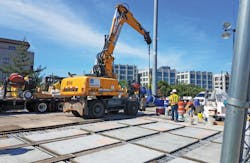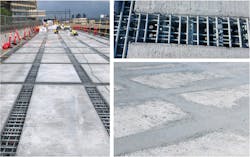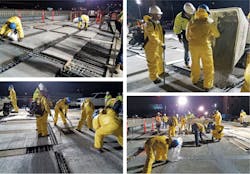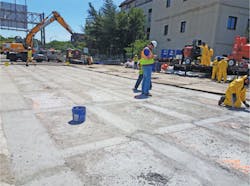The Pulaski Skyway is a three-and-a-half mile, four-lane roadway in the northeastern part of New Jersey. It connects Jersey City and Newark, traversing the Passaic and Hackensack Rivers, the New Jersey Meadowlands and Kearney Point. It’s an important artery for traffic in the area, connecting to the Holland Tunnel.
However, the Skyway was designed and constructed in the 1930s, and it carries a tremendous traffic load each day — about 74,000 vehicles per day as of 2014. Although trucks are prohibited from using it (and have been almost since the Skyway’s opening), it was still in significant disrepair, having become obsolete. In early 2013, the state-owned engineering firm China Construction Company (CCA) was engaged to repair the bridge. The New Jersey Department of Transportation had an ambitious plan. It wanted the bridge to be so thoroughly restored that no major repairs would be necessary for the next 75 years.
The Challenge
Tien Tran was the project manager for CCA on the eastern portion of the Skyway. “That involved full demolition and replacement of the deck and repair of some of the structural steel,” he says. It was a tricky business, however. The 12-span section in question — about 1,200 feet in length — connects to the west end of the Holland Tunnel, which bears traffic back and forth between New York and New Jersey.
“Getting the eastern portion of the Skyway up and running was the most urgent concern,” says Tran. “We had six or seven long weekends, Friday through Monday, to get the job done. We had to shoot the studs, install the rebar, place the precast panels and seal the joints so that traffic could be back on it by Monday morning at 5:00 a.m.”
Ultra-high performance concrete (UHPC) was originally specified for that purpose. The problem was the curing time for UHPC, which required 10 to 12 hours before traffic could get back on it. That was simply going to take too long.
Enter methyl methacrylate resin (MMA) based polymer concrete.
Accelerated Bridge Construction
Polymer concrete has been around since the 1950s, when it gained a lot of attention in Europe. Dr. Mahmoud Taha, Distinguished Professor and Chair of Civil Construction and Environmental Engineering at the University of New Mexico has done a lot of research on the product. He notes, “Polymer concrete doesn’t have any cement in it. Instead, it has organic hydrocarbons that act like superglue — plastics, basically. Because of that, it has a very high bond strength and durability. It won’t corrode with salt and can be used for repairs.”
In the case of the Pulaski Skyway, the polymer product was selected over UHPC because the latter is not designed to be a bond material, notes Taha. “If you put a lot of cement in UHPC, it shrinks, cracks and is not a good glue. However, polymer is impermeable, so water doesn’t enter the gap between the precast elements and it doesn’t shrink as much.”
CCA ended up using T-17, Transpo’s polymer concrete product, for the closure pours. “While UHPC and T-17 are both mixed onsite, the polymer concrete product cures faster,” notes Tran. It’s also easier to place. “It’s not labor-intensive in terms of forming,” he adds. “UHPC is poured using head pressure, and to get the air bubbles out, you have to use a top form. With polymer, you place it like normal concrete. You just trowel it into the area and finish it off.”
For the eastern portion of the Pulaski Skyway and its aggressive completion schedule, polymer concrete was the obvious choice. While this was the first time Tran had used T-17, he expects to use it again. He says, “At the end of the day, it allows you to do more intricate work in a shorter timeframe.”
The Advantages of Polymer Concrete
T-17 proved to be a winner on the Skyway project, ensuring a rigorous schedule was met and traffic was minimally disrupted, but there are other situations for which it’s an ideal solution.
Taha says, “Polymer concrete is good for any application where corrosion is a problem. You can put a thin 3/8-inch layer on top of bridge decks to handle weathering conditions, and its resistance to the elements also makes it useful in electrical and utility boxes. It’s a good choice for machine foundations because of its damping properties. And there’s a lot of interest now in using it in other applications, like offshore structures.” In fact, it’s ideal for any application that has exposure, such as manholes, or in places where corrosion is a problem.
Another advantage to the MMA material is that it can be applied in a wide range of temperatures — anywhere from 14° to 100° F. It’s chemical, UV-light, and freeze-thaw resistant, impermeable, waterproof and extremely fast-setting, with rapid strength gain as was demonstrated on the Pulaski Skyway.
The bottom line, however, is the durability of polymer concrete. Taha says, “It survives.”
Download the case study pdf here.



